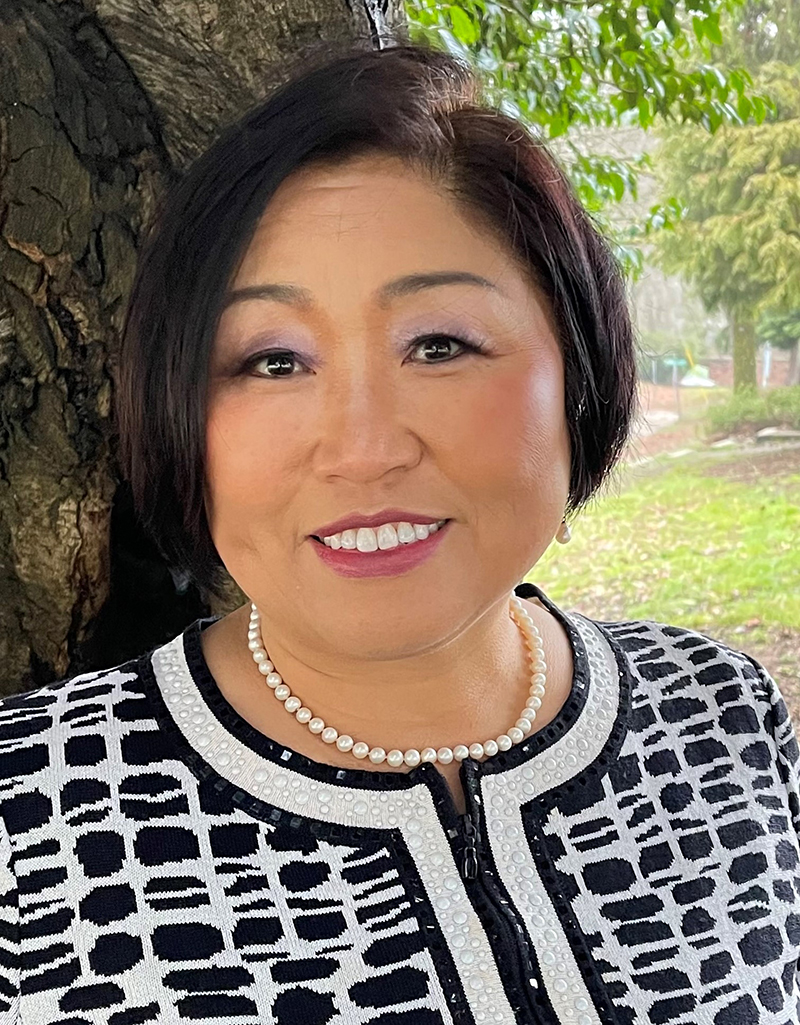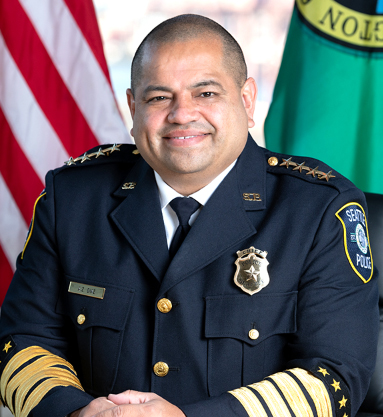By Mahlon Meyer
NORTHWEST ASIAN WEEKLY
Around town, in restaurants and in formal functions, on the street and in meetings with civic groups, Seattle Police Chief Adrian Diaz seems always outfitted in his uniform. So when he showed up in a Zoom meeting with about 50 members of the Korean American community on Tuesday wearing a purple suit with wide yellow stripes, the attendees were surprised, to say the least. Diaz explained he was in Boston University to give an address.
But the surprise seemed to turn to disappointment when Diaz, time and again, was unable to give the community members a simple explanation as to why two Korean business owners had recently been shot, and one killed, and how the police were going to make sure it never happened again.

Cheryl Lee is the executive director of the Korean Women’s Association (Photo provided by Cheryl Lee)
“We didn’t get all of the answers we were looking for,” said Cheryl Lee, executive director of the Korean Women’s Association, who organized and moderated the 40-minute discussion on Tuesday, in an interview with Northwest Asian Weekly afterwards. “But the optimist in me believes we’ve given the chief some things to think about.”
Was it a hate crime?
Lee’s purpose was, at least partially, attained, however.
“The Korean American community is in such terrific shock and anguish over the shooting of Eina Kwon and the subsequent death of her baby,” said Lee, referring to the woman who was fatally shot last week. “Especially since it followed so closely on the heels of the other shooting of the teriyaki business owner, that I wanted to move quickly and give them reassurance by bringing the police chief to meet with them personally.”
Hansoo Kim, a 58-year-old Korean American man, was killed in a robbery in January.
But just as the suit Diaz wore, which several members of the community asked about, seemed to dampen the effect of his official authority, so did his answers in many cases fail to meet the expectations of attendees.
Many asked repeatedly if the shooting was a hate crime.
“That was the first thing I asked my staff to look into,” Diaz said. But, repeatedly, he said there was no evidence that it was.
Rather, he returned again and again to explanations involving mental health, fentanyl, and the availability of guns.
Yet given the now almost-decade-long history of the repeated targeting of Asian Americans, not only by people experiencing mental health crises, but by many others, it seemed hard for the attendees to accept this explanation.
“The Korean American community is not convinced either way, whether it was a hate crime or not, but many are thinking that it was,” said Lee.
Seeking answers
During the meeting, voices cracking with astonishment pressed Diaz for more details, seemingly trying to comprehend the series of events that ended up with a mother lying on the street, dying.
“Have the police looked into the motive?” asked a reporter for a local Korean media outlet. “Was the shooter trying to give himself up?”
Diaz, when faced with questions such as these, repeatedly said he could not offer detailed comments lest they upend the ongoing investigation.
“I don’t want [the shooter] to be able to say, ‘The chief thinks I have mental health issues, so I should be let out,’” said Diaz. “There are deeper issues.”
Consolation offered
At the end of the meeting, after Diaz had signed off, Lee stayed on for about 10 minutes, listening to reactions, but mainly offering encouragement and consolation for what appeared to be some disappointment.
For instance, Diaz said it would probably be around two years until the shooter, a man who allegedly said he was having mental health issues, named Cordell Goosby, would be brought to trial.
Diaz had offered several explanations for the lengthy period and assured the meeting that Goosby would be held behind bars for the entire time.
Lee, in her closing remarks, consoled the attendees that although it seemed like a long time, they had to remain vigilant in order to follow the case to make sure justice was done.
“It takes so long to get to trial and convict him,” said Lee, who is also an attorney.
At the same time, she extolled the Korean American community for the many advances it has made in advocating for itself.
“Our Korean American community has come a long way, and I want to thank you all for actively engaging,” she said.
What will be done
For his part, Diaz said he had created a task force with 60 to 70 officers to target criminal activity in some of the most impacted areas, including downtown, the Chinatown-International District, and Aurora.
The selling of drugs, human trafficking, and guns would be targeted.
Asked when this would begin, Diaz said the additional policing had already begun, over the weekend, and there had already been a reduction in violent crime. Overall, however, there was still an uptick in crime, he said, although it had declined in some areas.
Diaz laid the blame on the reduced number of officers in the police department.
“We have to have people wanting to do this job,” he said.
Asked if there were Korean American officers or if he had plans to recruit any, his answers were met with repeated questions by the community members. Diaz said there were several such officers and several behind the scenes, which prompted even more questions.
At the same time, he said it appears that the next batch of recruits would be from among immigrants from Mexico, China, Ukraine, and Turkey.
In response to a question about his “long-term plans,” Diaz referred not only to efforts to recruit more officers, but also to Mayor Bruce Harrell’s plan, put into effect in April, to disrupt drug sales and enhance treatment programs, including a pilot program that offers cash incentives.
Diaz also said the city council should pass a law that it recently voted down which would have allowed the city to prosecute open-air drug use. Referring to the shooter as someone with mental health issues who was using drugs, he said, “We want to address the criminality of it, but we don’t want to be a revolving door.”
Diaz referred to efforts the police were undertaking with the mayor’s office.
“So the focus of our working group with the mayor will be how to get people into treatment.”
Drastic measures
According to Lee, first-generation Korean American immigrants generally are more conservative in their thinking about social problems.
“Obviously, I can’t speak for everyone, but many see the need to be hard on crime, and feel the police are not being allowed to do their job,” she said. “Others, for instance, in the second generation, say we need a balance between funding mental health and the police.” One thing that almost all members of the Korean American community have in common, however, is a strong support for gun control, she said.
“We are appalled by the rampant gun availability at all levels of society. Even the first generation would say this.”
In the end, Lee had at least one clear victory from the hastily-put-together gathering.
Diaz said he would very likely come to the funeral of Kwon. Lee said she hoped Harrell would also attend.
“This is a huge, huge, issue for our community, and it was on the heels of another Korean business owner who was also shot,” she said in her closing remarks. “There are definitely going to have to be drastic measures taken by your office, the mayor’s office and the city council.”
Mahlon can be reached at info@nwasianweekly.com.





Was this a hate crime? When Asian women are killed it is blamed on “mental illness.” When white women are killed it is blamed on “evil intent that has to be corrected.”